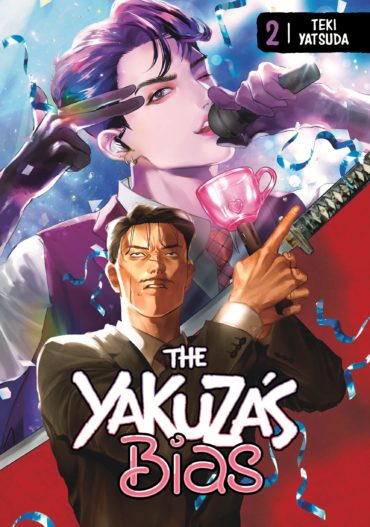The Yakuza’s Bias Volume 2 Review
‘Madcap fandom adventures of crazy gangsters’ (mangaka Teki Yatsuda)
It’s all down to Miss Megumi, high-schooler daughter of the head of the Washio clan. She dragged Ken Kanashiro, her father’s fear-inspiring second-in-command, along to a MNW concert and since that fateful night, Ken has become the most devoted K-pop fan ever. His devotion to his bias (favourite singer) Jun has even inspired his rival, Kinji Mizuhara, from the Jashima family – and now both men are diehard fans of the charismatic boy band. So when Megumi announces – in distress – that she can’t attend the upcoming concert (because of remedial classes for exams) Ken and Kinji go in her stead. But what’s this? There’s a handshake (event) in the offing – the chance to actually meet their idols in person – and Ken will not rest until he’s secured himself a ticket.
Meanwhile, the younger members of the Washio clan are becoming increasingly baffled by the change in their fearsome boss. But then Megumi’s mother, a very stylish and elegant woman, reveals that she’s just as obsessed with MNW as her daughter. The whole clan is summoned for a celebratory banquet by Ken, attended by Mrs. Washio in traditional kimono (presumably to maintain her high-ranking image as the boss’s wife) and it turns out it’s in honour of Jun’s birthday. Mrs. Washio is more than ready to take to the stage and sing until Ken joins her in a duet – and then Miss Megumi takes over. Mother and daughter face a slight problem though: they don’t speak Korean! “What a workout!” Miss Megumi says to Ken afterwards, exhausted but happy with her performance. “I don’t know Korean though, so I had to add a new language on the spot.”
But while Ken is so distracted by his bias, another rival clan has noticed and just as Ken and Miss Megumi are off to attend MNW’s hugely anticipated Comeback Concert, Masakichi Jinnai, second-in-command of the Kumazawa Syndicate makes his appearance. What terrible timing for a clan show-down!
Teki Yatsuda’s art captures just the right yakuza drama atmosphere while simultaneously turning it on its head. Ken’s crazed yakuza expressions are truly scary – and the young members of MNW are impossibly gorgeous, in true K-pop style. It’s impossible not to sympathize with the younger members of the Washio clan, though, as they try to work out what on earth is going on yet fail to understand the magic of MNW. Nevertheless, amusing though the antics are, by this second volume, it’s not quite as fresh as it was; Ken’s shouting (effectively amplified by Nicole Roderick’s apt use of ‘loud’ lettering) becomes a little wearing to read after a while and the ‘tough yakuza is transformed by the power of K-pop’ shtick is becoming just a little tired in places. The series is apparently ongoing – and it still has many endearing moments (a strange description, I suppose, for a yakuza series) – as well as fascinating insights into the mindset of the band members, so it’s very readable for that aspect alone.
Max Greenway delivers another excellent translation for Kodansha and the translation notes at the end are really helpful, especially in explaining terms from K and J-pop fandom. There’s a colour page at the front and the cover art has metallic embossing again to enhance the snazzy showbiz look (a great cover design for Kodansha from Phil Balsman). Volume 3 is tentatively scheduled for January 2024.
Our review copy from Kodansha was supplied by Diamond Book Distributors UK.


